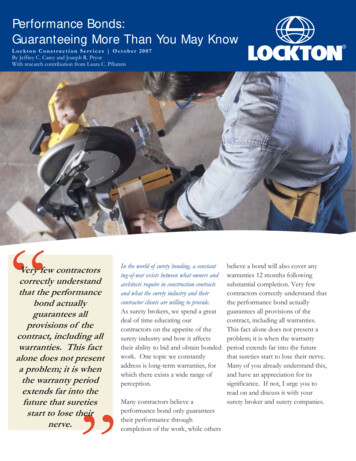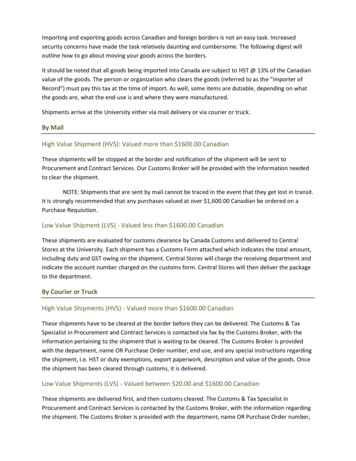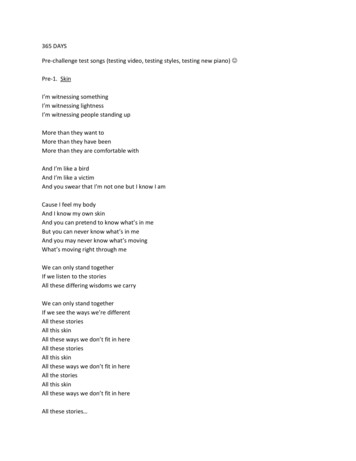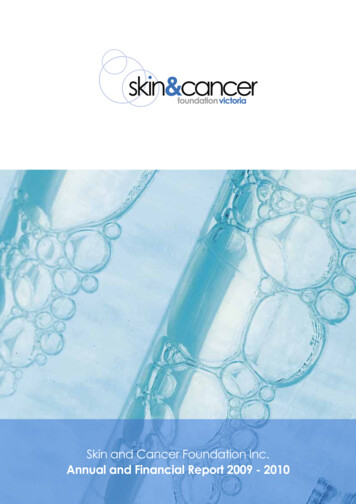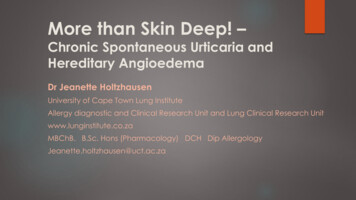
Transcription
More than Skin Deep! –Chronic Spontaneous Urticaria andHereditary AngioedemaDr Jeanette HoltzhausenUniversity of Cape Town Lung InstituteAllergy diagnostic and Clinical Research Unit and Lung Clinical Research Unitwww.lunginstitute.co.zaMBChB. B.Sc. Hons (Pharmacology) DCH Dip AllergologyJeanette.holtzhausen@uct.ac.za
Declaration of Conflict of Interest No conflict of interest to declare Clinical research physician and limited private practice,UCT Lung Institute, Cape Town, South Africa
Overview Define urticaria and angioedema Basic approach to ‘itching and swelling’ Investigation and treatment of ChronicSpontaneous Urticaria Illustrative urticaria cases Discuss angioedema, in particularhereditary angioedemawww.geology.uct.ac.za/cape/town/geology
Who is this lady in the painting?Public Domain, https://commons.wikimedia.org/w/index.php?curid 1372096An example of a drawing, of "Paradise", her SouthAfrican residence
Where was thispicture takenand what do youhave to look outfor in this area?
Kirstenbosch National Botanical Gardens
Urticaria named after Urticaeceaespecies of stinging nettle plantsThe Latin root of the wordurticaria is urere, meaning –‘to burn’, as is evident in thefamily name of theUrticaceae stinging nettleplants. The classic ‘whealand flare’ histamine responseis illustrated by thediscomfort experienced uponcutaneous contact with theseplants!
Urticaria – clinical features Polymorphic, raised and erythematous lesions Vasodilatation Increased vascular permeability Following release of mediators by mast cells Individual lesions resolve within 24 hours No scarring – epidermis not involved Intensely pruritic Rash tends to ‘migrate’ or become confluent.
Mast cell degranulation in 2170 fig1 in-affected-skin
Angioedema Swelling of deep dermis, subcutaneous ormucocutaneous tissue Due to vascular leakage Face, eyelids and lips commonly affected May affect limbs, gastro intestinal system, airway Painful lesions, rather than pruritic Take up to 72 hours to resolve Can be histamine mediated or through thecomplement/bradykinin pathwayPicture - https://en.wikipedia.org/wiki/Angioedema
Where to Start - History is MOST IMPORTANT!EAACI/GA2LEN/EDF/WAO 2013 urticaria guideline - recommended key questionsEAACI, European Academy forAllergy and ClinicalImmunology; EDF, EuropeanDermatology Forum; GA2LEN, GlobalAllergy and Asthma EuropeanNetwork; WAO, World AllergyOrganization.Reproduced from Zuberbier et al.Allergy 2014;69(7):868–87.
Patient presents with ‘itching andswelling’ – Key questions Is it urticaria? (Consider alternative dermatologicaldiagnosis 24 hours, epidermis involvement, vasculitis )Does the patient present with urticaria, angioedema orboth?Duration (6 weeks – Acute or chronic)Is there atopy, allergy, anaphylaxis on historyWhat are the triggers IN THIS CASEPhysical factors, foods, medicines or additives, stress,underlying medical conditions?Does it respond to antihistamines or not, QOL?
Simplified approach to investigating urticaria and or angioedema –START by taking a good history regarding the hives and or swellingadapted from EAACI/GA2LEN/EDF/WAO 2013,Urticaria withAtypical features?Urticaria /- angioedemaAssociated fever,joint pain, malaiseIndividualurticarial lesions 24 hoursConsider autoinflammatorydisease/ underlyingconditionConsider skinbiopsy, vasculitisInterleukin14,11,16Duration oflesions andtriggers?Induciblesymptoms,provocationtest : CInd 6 weeks,triggerspresent,other allergysymptoms –specific IgE/CAST 6 weeks, noclear triggers,diagnoseCSU, considerFBC, ESR,thyroid orCAST tests foradditivesHistamine and other mast cell mediatorsAngioedema aloneACEinhibitors?No C3/C4, C1esteraseinhibitor?Yes –stopACE-1Noresponse/answerBradykinin
Chronic spontaneous urticaria Daily/ frequent occurrence Pruritic Hives and/ or Angioedema 6 weeks Distinguished from inducible types Synonym Chronic Idiopathic Urticaria “Easy to diagnose, difficult to treat”Figure 1 Symptoms of urticaria.(a) Hives – central swellings of variable size, often surrounded byreflex erythema. Associated with itching; individual hives usuallyresolve within 1–24 h;(b) Angioedema – sudden, pronounced erythematous or skincoloured swelling of the lower dermis and subcutis with frequentinvolvement below mucous membranes. Sometimes associatedwith pain rather than itching; resolution can take up to 72 h.Photographs (a) courtesy of Novartis Pharma AG; (b) reproducedwith kind permission from UNEV; patient consent received.Published in JEADV 2016 (Suppl 5), 9
Diagnostic tests for ChronicSpontaneous UrticariaEAACI/GA2LEN/EDF/WAO 2013RoutineExtendedDifferential blood countInfectious diseasesESR/CRPType 1 allergy (IgE)Omission of suspected drugsAuto-antibodiesThyroid hormonesSkin testsPseudoallergensSerum tryptaseASST (autologous serum skin test)Skin biopsy (vasculitis)Extended tests not routinely recommended– choice based on clinical evaluation (PERSONAL AND FAMILY HISTORY NB)
CSU – Current treatment guidelines(EAACI/GA2LEN/ EDF/ WAO 2013) 1. First line – Modern second generation antihistaminesIf symptoms persist after 2 weeks 2. Second line – Increase dosage to 4 fold of modernsecond generation antihistaminesIf symptoms persist after afurther 1 to 4 weeks 3. Third line – Add to second line Omalizumab orCiclosporin A or Montelukast* Short course steroids 10 days used at any time for exacerbations
Case 1 – Mr. Nick de Kick Rugby player with high aspirations History of seasonal allergic rhinitis Now pruritic skin rashes Triggers – sweat and exercise Contact with grass ‘Strapping’ plasters
Case 1 - Mr. Nick de Kick Featuresof allergic rhinitis Dermatographism Fine cholinergic urticaria Also – T cell mediated contactdermatitis reaction in distributionwhere strapping had been applied How would you investigate him?https://en.wikipedia.org/wiki/Cholinergic urticaria
Case 1 Mr. Nick de Kick No angioedema Typical cholinergic urticaria, individual lesionsresolve in less than 24 hours 6 weeks, but recently exacerbated sincetraining intensified Features of atopy, clear triggers (grass, exercise),no anaphylaxis Co-morbid contact dermatitis to plaster glue,allergic rhinitis Partial response to OTC antihistamines
Mr. Nickde KickSimplified approach to investigating urticaria and or angioedema –START by taking a good history regarding the hives and or swellingadapted from EAACI/GA2LEN/EDF/WAO 2013,Urticaria withAtypical features?Urticaria /- angioedemaAssociated fever,joint pain, malaiseIndividualurticarial lesions 24 hoursConsider autoinflammatorydisease/ underlyingconditionConsider skinbiopsy, vasculitisInterleukin14,11,16Duration oflesions andtriggers?Induciblesymptoms,provocationtest : CInd 6 weeks,triggerspresent,other allergysymptoms –specific IgE/CAST 6 weeks, noclear triggers,diagnoseCSU, considerFBC, ESR,thyroid orCAST tests foradditivesHistamine and other mast cell mediatorsAngioedema aloneACEinhibitors?No C3/C4, C1esteraseinhibitor?Yes –stopACE-1Noresponse/answerBradykinin
Case 1 Mr. Nick de Kick Management Skin prick testing confirmed IgE mediated allergy tograss pollen MIXED PICTURE – grass pollen allergy, cholinergicurticaria, T cell mediated skin reactions to strapping Intranasal steroid and rupatidine prescribed Urticaria completely controlled at follow up Advised to try hypo-allergenic strapping Consider patch testing Consider grass pollen SLIT
Case 2 - Ms. Numara Sleep 31 year old female5 months postpartum – breastfeedingUrticaria and angioedema ‘off and on’ in the past,but severe since birth of baby – distressedPhysical examination unremarkable, mild ‘sinus’General practitioner hesitant to prescribeantihistaminesMultiple ER visits – needed parenteral steroids,antihistamines – CAN WE HELP THIS .php?image 17108&picture breastfeeding&large 1
Case 2 - Ms. Numara Sleep Typical urticarial wheals Angioedema also present Longstanding - 6 weeks – chronic by definition Unsure about atopy status Triggers immune modulatory effect ofpregnancy, stress and sleep deprivation Family history – mother has hypothyroidism
Ms. NumaraSleepSimplified approach to investigating urticaria and or angioedema –START by taking a good history regarding the hives and or swellingadapted from EAACI/GA2LEN/EDF/WAO 2013,Urticaria withAtypical features?Urticaria /- angioedemaAssociated fever,joint pain, malaiseIndividualurticarial lesions 24 hoursConsider autoinflammatorydisease/ underlyingconditionConsider skinbiopsy, vasculitisInterleukin14,11,16Duration oflesions andtriggers?Induciblesymptoms,provocationtest : CInd 6 weeks,triggerspresent,other allergysymptoms –specific IgE/CAST 6 weeks, noclear triggers,diagnoseCSU, considerFBC, ESR,thyroid orCAST tests foradditivesHistamine and other mast cell mediatorsAngioedema aloneACEinhibitors?No C3/C4, C1esteraseinhibitor?Yes –stopACE-1Noresponse/answerBradykinin
Case 2 – Ms. Numara Sleep Skin prick tests negative to inhalant allergens (history of‘sinus’ - viral infections) Ordered FBC - Normal, ESR 14 mm/hr. CAST’s declined – cost and ‘clean diet’ Thyroid function and auto-antibody investigationsResults - Free T4 10.6TSH 8.12 H(7.2 – 16.4 pmol/L)(0.38 – 5.33 mIU/Subclinical hypothyroidism
Case 2 – Ms. Numara SleepTHYROGLOBULIN AB46.6 HThyroid Peroxidase Ab 1068.0 H (0-9 Iu/mL) Clinical significance? Possible auto-immune mechanism for CSU- thyroid auto-antibodies interacting withthe mast cells? Managed as CSU – Cetirizine/ Levocetirizine Reassured that continued breastfeedingwhile weaning acceptable despiteantihistamines Follow up of thyroid functions, possibleendocrinology referral Omalizumab potential future option for her(0-4.0 IU/mL)
Association between CSU andthyroid auto-immunity Anti-thyroid peroxidase, Anti-thyroglobulin antibodies Patients with ASST more likely to have thyroid disease/antibodies (Lunge et al) CSU associated with thyroid disease/ auto-immunityoften severeKIM et al, Korea 2016:184 patients with CSU43 (23 %) -anti thyroid antibodies26 (14 %) -thyroid dysfunction(Hyper and hypothyroidism)Only 2 patient’s urticariaimproved after Rx of thyroidcondition
Case 3 – Ms. Truly Desperate 42 year old marketing manager Background of well controlled asthma andrhinitis However – allergic to her 5 cats! 18 months history of severe urticaria No angioedema Mom has rheumatoid arthritis
Case -3 Ms. Truly Desperate Avoiding gluten, diary and sugar – multiple ‘triggers’On omega 3 and probiotics ex naturopathLongstanding depression well controlled oncitalopramOral contraceptive tabletOn fexofenadine 180 mg am, Phenergan 25 mg pmRelying on Celestamine and steroid injections‘It’s the only thing that helps’!
Who wants to suggest a plan?
Ms. Truly Desperate Challenging case and personality!Definitely atopicLongstanding disease – chronic, urticaria withoutangioedemaConfusing detailed list of triggers – palm oil to tightclothingPsychological factors and stress likely to becontributorySeemingly unresponsive to antihistaminesSteroid dependent
Ms. TrulyDesperateSimplified approach to investigating urticaria and or angioedema –START by taking a good history regarding the hives and or swellingadapted from EAACI/GA2LEN/EDF/WAO 2013,Urticaria withAtypical features?Urticaria /- angioedemaAssociated fever,joint pain, malaiseIndividualurticarial lesions 24 hoursConsider autoinflammatorydisease/ underlyingconditionConsider skinbiopsy, vasculitisInterleukin14,11,16Duration oflesions andtriggers?Induciblesymptoms,provocationtest : CInd 6 weeks,triggerspresent,other allergysymptoms –specific IgE/CAST 6 weeks, noclear triggers,diagnoseCSU, considerFBC, ESR,thyroid orCAST tests foradditivesHistamine and other mast cell mediatorsAngioedema aloneACEinhibitors?No C3/C4, C1esteraseinhibitor?Yes –stopACE-1Noresponse/answerBradykinin
Case 3 Ms. Truly Desperate:Investigations Normal physical exam and acceptable lung functions Dermatographism SPT positive cats, dogs, grass and birds CASTs moderately reactive to benzoates Normal FBC, ESR, CRP Negative rheumatoid factor and auto-immune screen Normal thyroid function and negative thyroid autoantibodies
Case 3 Ms. Truly Desperate Management No response to increasing doses, various chemicalclasses of antihistamines Eliminating alcohol and benzoates helped, but still hadsevere distressing symptoms Self imposed dietary restrictions affecting QOL Ongoing reliance on oral steroids – weight gain,Cushingoid appearance and adrenal suppression a realconcern No response to omalizumab Patient resigned from stressful job – thereafter slowlyweaned off steroids.
Omalizumab in CSU Glycosylated IgG monoclonal antibody producedby cells of an adapted Chinese hamster ovary(CHO) cell line.Licensed for severe allergic asthmaSince 2014 in patients 12 with CSUBinds to free IgEMast cell downregulates high affinityIgE receptors Anaphylaxis risk – administration in hospital settingEffective in 75 % of patients, but COST is an issue
Psychological factors in urticaria Condition may start / flare up during times of “stress”(bereavement, overseas travel, business meetings,wedding and honeymoon! ) Urticaria also causes psychological distress due tointense pruritus and embarrassing appearance Severe impact on quality of life – functional andsleep impairment common Not to be trivialised – offer emotional support
Urticaria - conclusionsMast cells, histamine mediated Distinguish acute vs chronic urticaria (6 weeks) History important to determine investigations – use algorithm andguidelines (NO reflex ticking of boxes!) Chronic spontaneous urticaria NOT usually IgE mediated Variable triggers (e.g. physical factors, food additives, auto-immuneor underlying conditions, stress)Majority can be managed by high dose non-sedating antihistaminesAvoid excessive oral steroids – short courses onlyOmalizumab may be a game changer in severe cases
Chronic urticaria consultation – common scenario!
Who was this famous doctor?What is the relevance to our topic?"Listen to your patient, he istelling you the diagnosis”“Medicine isa science ofuncertaintyand an art ofprobability.”“It is much moreimportant to knowwhat sort of patienthas a disease, thanwhat disease apatient has.”He has frequently been described as the "Father ofModern Medicine" and one of the "greatest diagnosticiansever to wield a stethoscope"
Sir William Osler The Four Doctors by John Singer Sargent, 1905, depictsthe four physicians who founded Johns Hopkins Hospital.The original hangs in the William H. Welch MedicalLibrary of Johns Hopkins University.From left to right: William Henry Welch, William StewartHalsted, William Osler, Howard KellyFounder John Hopkins HospitalLater Professor at OxfordIntroduced clinical bedside training,residency and internship to medicaltraining – ‘8 years of monastic life’!Many clinical signs and diseasesnamed after himAlso first to notice hereditary nature ofcertain angioedema caseshttps://en.wikipedia.org/wiki/William Osler
Key questions – angioedema ?
Angioedema Histaminergic/ mast cell mediated - acute setting inassociation with specific allergy or anaphylaxis Idiopathic (often in association with chronicurticaria) – may respond to antihistamines Non- allergic adverse drug reaction to AngiotensinConverting Enzyme (ACE) Inhibitors Hereditary – HAE Type 1, 2 and 3 – due todecreased level or function of C1 inhibitor enzyme Acquired C inhibitor 5208-overview
Angioedema (non mast cell mediated) Asymmetric, nondependent swelling of deeptissues Painful rather than pruritic Occurs without wheals Bradykinin mediated swelling ACE- Inhibitors most common cause Differential includes hereditary angioedema(HAE), acquired C1-inhibitor deficiency andidiopathic angioedema
J Allergy Clin Immunol June 2013
Angioedema due to ACE-inhibitors Angiotensin Converting Enzyme – dipeptidylcarboxypeptidase important in breakdown ofbradykininACE-Inhibitors – inhibits the enzyme therebyprolonging breakdown of bradykinin, leading toangioedemaACE-I associated with angioedema in 0.1 to 0.7% ofpatientsCOMMON due to wide use of these drugs (increasingchronic diseases of lifestyle, strong indications indiabetes, renal and cardiac conditions )Class effect – not ‘allergic’/ immune mediatedAngiotensin Receptor Blockers (ARB’s) less commonlyassociated, but also possible
Angioedema due to ACE-inhibitors Face and tongue frequently involved – AIRWAY NB during acuteattacks!!!Can happen at any time, even after YEARS of treatmentClass effect to all ACE-InhibitorsAfrican patients are more at risk, also females, smokers and withincreasing ageAcute treatment controversial – AH’s, adrenaline tried but not effectiveFFP, specific Rx for HAE has been tried, tracheostomy may be neededManagement - discontinuation, Medic Alert, counselling“ AVOID THE ACE of Spades”ARB’s – modest risk of recurrence (only use with cautionif benefits outweigh risks – C/I according to package inserts)
Hereditary angioedema Autosomal dominant condition Offspring of affected parents have a 50 %C1 inhibitor is important regulator of complement pathway Autosomal dominantcondition Incidence - 1:50 000 ‘Runs in families’ – childof affected person has50% chance of beingaffected New mutations canoccur Type I, II – distinguishedby C1 inhibitor levels,functional assays Type III – Poorlyunderstood, mostlyfemales – associationwith menstrual cycle,oestrogen levels
Hereditary angioedema - simplified pathophysiologyHAE results from mutations in gene encoding C1 inhibitor, a key plasma protease inhibitorinvolved at multiple points in the contact, fibrinolytic and complement systems. Normally C1inhibitor prevents the cascades from becoming over active. In HAE, inadequate amount orineffective C1 inhibitor can not regulate cascades and overproduction of bradykinin results.
Clinical manifestations of HAEOnset of symptoms often after puberty Attacks may be classified as peripheral,gastrointestinal or involving the airway Delay in diagnosis (often 8 years!) common Inappropriate treatment, especially for GI attacks Family history useful, but not always present Attacks may be triggered by surgery, trauma orstress Prodromal symptoms may include fatigue,irritability, nausea, rash – individual variation
Clinical manifestations HAE
Case 4 – Sarel Swellings 25 year old male History of spontaneous non pitting oedema of hands,feet and genital area since adolescence Painful, takes long to resolve Previous admission for intravenous fluids following severeabdominal cramps and vomiting, regarded as foodpoisoning Emergency room admission for angioedema of the faceand airway
Mr. SarelSwellingsSimplified approach to investigating urticaria and or angioedema –START by taking a good history regarding the hives and or swellingadapted from EAACI/GA2LEN/EDF/WAO 2013,Urticaria withAtypical features?Urticaria /- angioedemaAssociated fever,joint pain, malaiseIndividualurticarial lesions 24 hoursConsider autoinflammatorydisease/ underlyingconditionConsider skinbiopsy, vasculitisInterleukin14,11,16Duration oflesions andtriggers?Induciblesymptoms,provocationtest : CInd 6 weeks,triggerspresent,other allergysymptoms –specific IgE/CAST 6 weeks, noclear triggers,diagnoseCSU, considerFBC, ESR,thyroid orCAST tests foradditivesHistamine and other mast cell mediatorsAngioedema aloneACEinhibitors?No C3/C4, C1esteraseinhibitor?Yes –stopACE-1Noresponse/answerBradykinin
Investigations for Hereditary Angioedema
NB – Acquired C1 inhibitor deficiency may be associated with haematological conditions
Management of HAE
HAE treatment - EmergencyNo response to anti
Case 2 - Ms. Numara Sleep 31 year old female 5 months postpartum –breastfeeding Urticaria and angioedema ‘off and on’ in the past, but severe since birth of baby –distressed Physical examination unremarkable, mild ‘sinus’ General practitioner hesitant to prescribe antihistamines



